
Though many of us never venture much further off-road than the Woolies carpark, we’re obsessed with SUVs. Then there are those who want these bulky, high-riding load-luggers to also perform and handle like sports cars. To please them, engineers at Porsche, Mercedes-Benz, BMW, Land Rover and Jaguar, among others, have spent countless hours on this Mission Impossible.
The Kona N is Hyundai’s attempt at rewriting the laws of physics, its first performance SUV.
Hyundai's newest N model marries its strikingly-styled small SUV with go-fast hardware from the impressive i30N hot hatch, including the new 206kW and 392Nm iteration of the 2.0-litre turbocharged four banger and the N-spec version of the new eight-speed dual-clutch transmission.
The suspension features heavy-duty components such as redesigned steering knuckles, plus new springs and electronically controlled shocks.
The front-wheel-drive Kona N also gets the N-spec electronically-controlled limited-slip differential, a revised power-steering system with an e-motor mounted on the rack rather than the steering column to improve response and sensitivity, 19-inch forged alloy wheels wrapped in Pirelli P Zero 235/40 tyres developed specifically for the car, and bigger brakes – 360mm vented rotors up front and 314mm vented items at the rear.
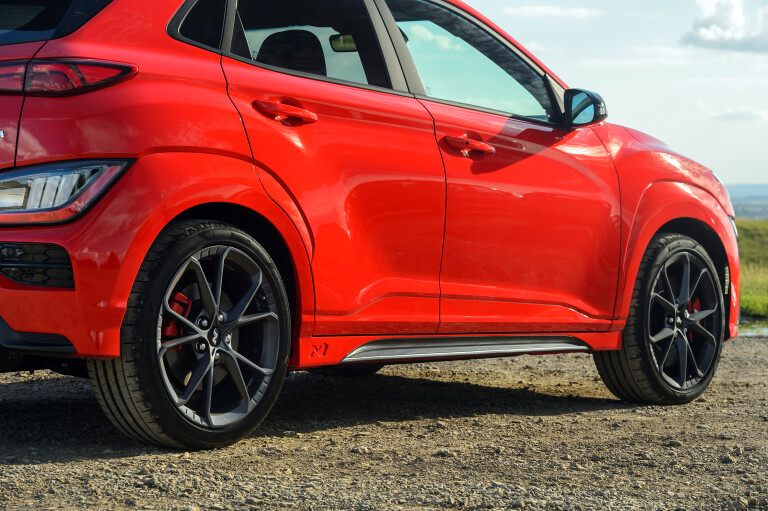
Outside, the front and rear bumper fascias are similarly architected to those of the Kona N Line, but the front splitter has been extended 10mm, while at the rear exhaust outlets the size of bazookas now frame the faux diffuser.
Other visual cues include a large, double-wing roof spoiler extending from the roof and splashes of red on the lower edges of the bodywork and on the brake calipers.
Inside are the N-spec steering wheel, shifter and heavily bolstered seats, all finished in the familiar N palette of black trim with blue accents.
Hyundai’s N division was established by former BMW M chief Albert Biermann. And though Biermann is now head of R&D for the entire Hyundai-Kia group, its enthusiast credentials remain rock solid.
Take this little gem, quoted verbatim from the official press kit: “N is one of few hot SUVs with a manual handbrake instead of an e-brake, allowing adventurous drivers to enjoy slides.”
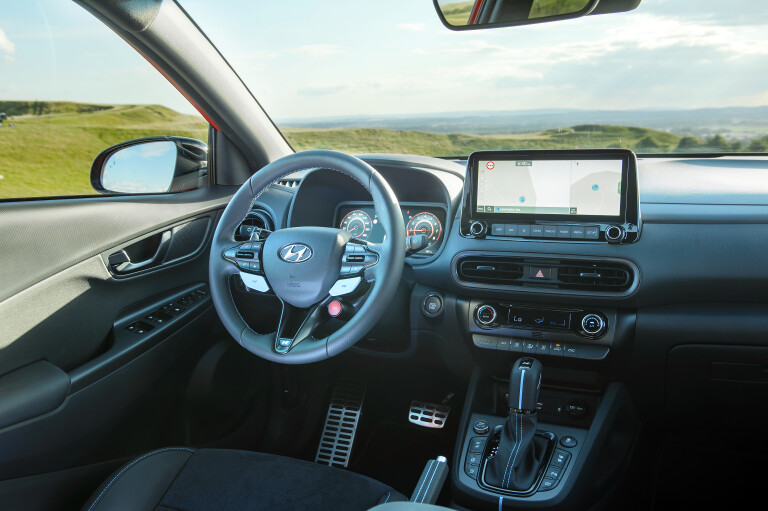
The front-wheel drive Kona N gets the N-spec electronically controlled limited slip differential, a revised power steering system with improved response and sensitivity
Alexander Eichler, a former Bosch engineer now working at the Hyundai-Kia tech center in Rüsselsheim to hone the dynamics of all the company’s cars and SUVs, sums up the Kona N’s mission statement this way: “The target was to make it drive like the i30N.”
Job done, at least in a straight line: By Hyundai’s own numbers the Kona N is only a tenth of a second slower than the i30N to 100km/h, taking 5.5 seconds with launch control, and 6.4 seconds without.
But Eichler readily concedes you can’t argue with Isaac Newton in the twisty bits. Boasting the same 173mm ground clearance as the regular Kona, the Kona N is 120mm taller than the i30N. It also weighs about 30kg more “The biggest challenge with the Kona N was its higher center of gravity and higher seating position,” he says, “so we had to make it quite stiff to be as sporty as the i30N.”
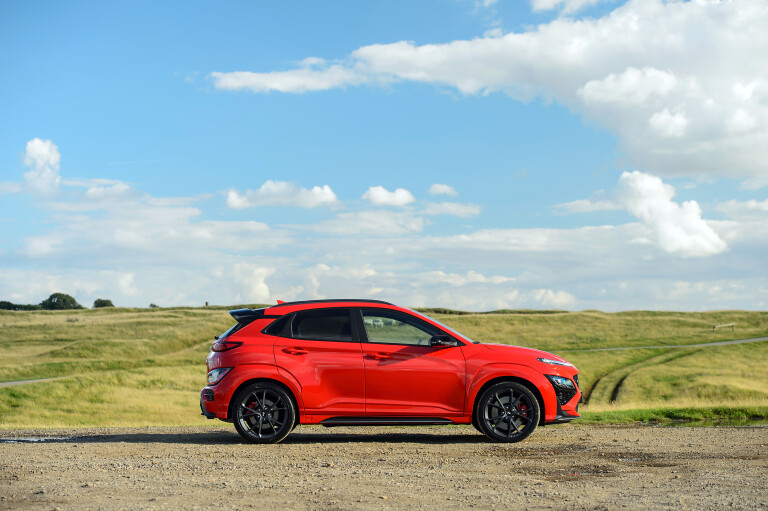
Now, when a German chassis engineer tells you a car has stiff suspension, hold on to your kidneys. And with the dampers set in anything other than Normal mode, the Kona N’s ride is indeed brutal, with heaves and humps instantly transformed into violent vertical body motions that can unsettle both car and driver.
Eichler admits Hyundai’s own hotshoes put the suspension in Sport mode rather than full commando N mode to nail a quick lap at the Nürburgring Nordschleife, a track whose endlessly undulating topography is the ultimate test of chassis composure.
“Generally, the philosophy of the N mode is to be optimized for a really flat racetrack,” he says. “We do not expect our vehicle to perform well in N mode on public roads.”
Leaving aside any discussion as to why anyone would want to take an SUV to a racetrack in the first place, we’ll give Eichler points for honesty. But, as we found on the back roads of leafy Warwickshire, the Kona N is not quite as one dimensional as you might think.

Despite 39Nm more torque and a flatter torque curve – all 392Nm is available from 2100rpm through to 4700rpm – the Kona N’s engine still feels a little dozy below 2500rpm. It’ll mooch around happily enough at low revs in Normal mode with the dual-clutch tranny shifting itself, but if you’re having a lash, using the paddles to shift manually, it’s happiest kept spinning between 3000rpm and 6000rpm.
It's not a high-revving powerplant – everything's pretty much done and dusted by 6200rpm – but it doesn't need to be.
The new eight-speed dual-clutch transmission is quick and smooth and allows you to make the most of that broad swathe of mid-range grunt. Designed and built in-house by Hyundai, the DCT is a wet-clutch design, meaning it pumps oil on to the clutches to keep them cool, allowing them to handle more torque.
With the powertrain switched to N mode, the sophisticated control software allows for near seamless upshifts when it detects more than 90 per cent throttle being used.
The transmission’s neatest trick, though, is what Hyundai calls Track Sense Shift. In N mode, the Kona N can sense when it is being driven on a track and activates an adaptive shift protocol designed to automatically deliver both upshifts and downshifts at precisely the right moment.
We’ll wait until we get the car on a circuit we know before making a definitive call, but on the poky little test track Hyundai included in the drive program, it felt as brilliantly intuitive as Porsche’s PDK in Sport Plus, shuffling the ratios quicker, more authoritatively than could be managed by fanning the paddles on the steering wheel.
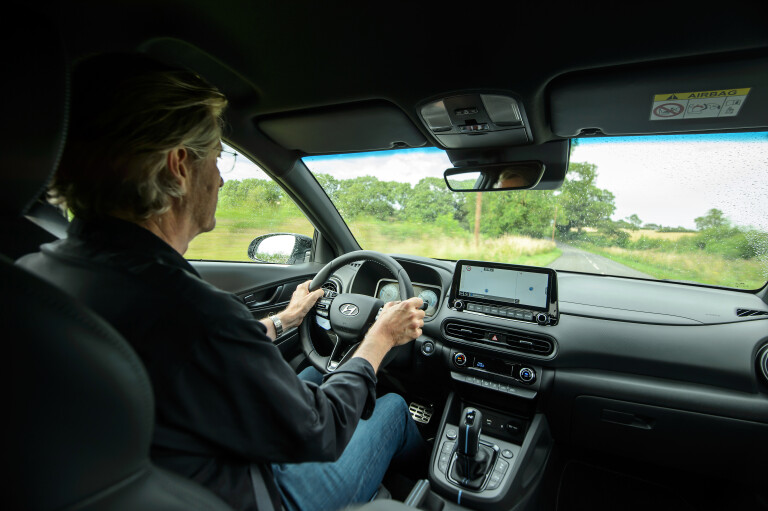
As with other N models, the Kona N comes standard with not only launch control, but also rev matching and the ability to completely switch off the stability control nannies.
N Grin Shift is a cartoonish moniker for a button on the steering wheel that does pretty much the same thing Porsche’s Sport Response button does in a Sport Chrono Pack-equipped 911, switching the engine and transmission to their highest response modes for 20 seconds, no matter what mode you’re driving in. Push to pass, in other words.
To get the best out of the Kona N on a good driving road, you’ll want to make sure you’ve pre-set the Custom tab in the N settings menu to allow the powertrain to stay in maximum attack mode while having the suspension and steering in their softer Normal settings. Configured this way, the Kona N does indeed drive like an i30N. On stilts.
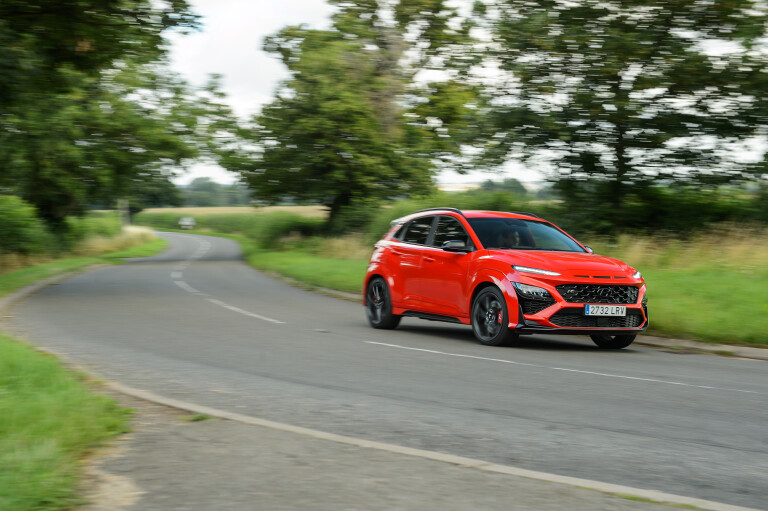
You’ll want to preset the Custom tab to keep the powertrain in maximum attack with the suspension and steering in Normal. Configured this way, the Kona N does indeed drive like an i30N. On stilts.
Even with the suspension in its softest setting, the ride is still very firm, but the more compliant damping allows the chassis to breathe over lumps and bumps, keeping the tyres in contact with the tarmac.
You’ll notice a slight latency on changes of direction when compared with the i30N, not the least because your bum and inner ear are further away from the tarmac. But once it’s worked through the transients, the Kona N grips with the same tenacity as its low-slung sibling.
As in the i30 N, the front end is astonishingly consistent, especially under load. That trick e-diff means you can get on the power almost as soon as you’ve rotated the Kona N towards the apex and stay on the power all the way through the corner.
You’ll notice some torque steer under full power in N mode, especially on uneven roads, as the e-diff vectors optimum torque to each front wheel, but the traction is deeply impressive. The front end will go exactly where you point it, the rear axle tracking it faithfully all the way.
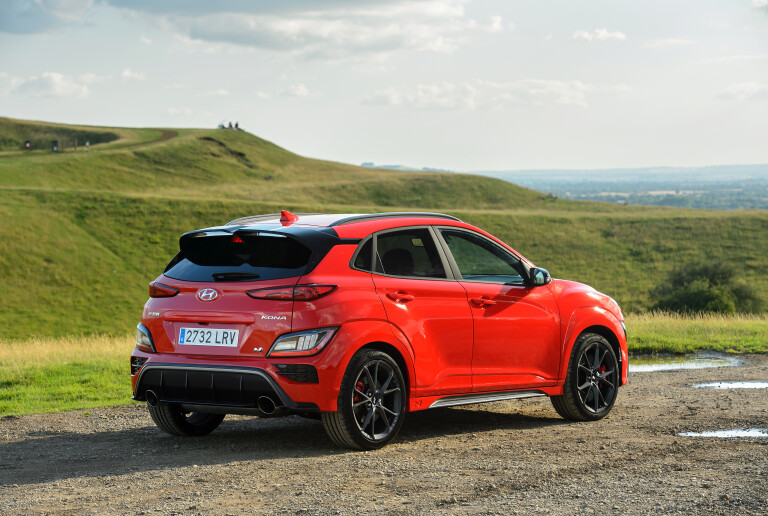
The laws of physics are immutable, however: No SUV can ever accelerate, stop, or steer as well as a lighter and lower car fitted with the same performance hardware.
If you want a proper Hyundai hot hatch buy the i30N, or wait for the i20N, a little zinger of a thing that puts the Fiesta ST on notice.
If you need a small SUV and want something that is genuinely quick and entertaining to drive, though, the Kona N is not only less compromised and more accomplished than you might expect, but also good value.
The Kona N will be available in two trim levels, each priced within a few grand of the i30 N manual and auto models. The entry level Kona N starts at $47,500, and the Kona N Premium, which adds suede and leather trim, heated and cooled power front seats, a glass sunroof, and a head-up display, among other things, starts at $50,500.
Exact timing is still to be confirmed, but the Kona N is due here in the third quarter of 2021.
2021 Hyundai Kona N specifications
| Body: | 5-door, 5-seat compact SUV |
|---|---|
| Drive: | front-wheel drive |
| Engine: | 1998cc turbo petrol four-cylinder, DOHC, 16V |
| Bore x Stroke: | 86 x 86mm |
| Compression: | 9.5 |
| Power: | 206kW @ 5500 rpm |
| Torque: | 392Nm @ 2100-4700 rpm |
| Power/Weight: | 136kW / tonne |
| Transmission: | 8-speed dual-clutch automatic |
| Weight: | 1510kg (kerb) |
| Suspension: | McPherson struts, coil springs, electronically controlled shocks (f), multi-link, coil springs, electronically controlled shocks (r) |
| L/W/H: | 4215/1800/1565mm |
| Wheelbase: | 2600mm |
| Tracks: | 1579mm front, 1575mm rear |
| Steering: | electrically assisted rack-and-pinion |
| Brakes: | Dual-Diagonal, Split-Circuit, Power Assisted + EBD. Ventilated discs – 360mm front, 314mm rear |
| Wheels: | 19 x 8.0-inch (front/rear) |
| Tyres: | 235/40 R19 (front/rear), Pirelli P Zero |
| Price: | $47,500 plus on-road costs |



COMMENTS